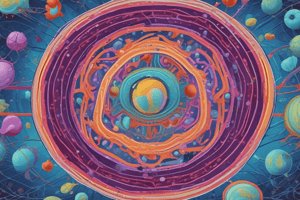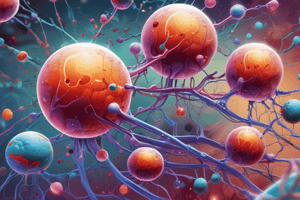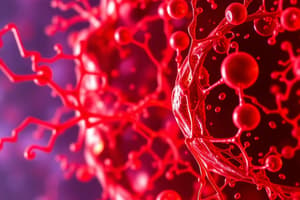Podcast
Questions and Answers
Apoptosis is also known as ______ cell death.
Apoptosis is also known as ______ cell death.
programmed
Damaged cells or cells that reached the end of their functional lives are chopped and packaged into ______ and digested by scavenger cells.
Damaged cells or cells that reached the end of their functional lives are chopped and packaged into ______ and digested by scavenger cells.
vesicles
Ced-9 is an ______ inhibiting protein.
Ced-9 is an ______ inhibiting protein.
apoptosis
Cytochrome C functions in ______ electron transport but acts as a cell death factor when released.
Cytochrome C functions in ______ electron transport but acts as a cell death factor when released.
Internal signals can result from ______ DNA damage or excessive protein misfolding.
Internal signals can result from ______ DNA damage or excessive protein misfolding.
Cells use chemical energy stored in ______ molecules to generate ATP.
Cells use chemical energy stored in ______ molecules to generate ATP.
Catabolic pathways release stored energy by breaking down ______ molecules.
Catabolic pathways release stored energy by breaking down ______ molecules.
Fermentation is a type of ______ degradation of sugars that occurs without O2.
Fermentation is a type of ______ degradation of sugars that occurs without O2.
The Calvin cycle uses ______ and NADPH to reduce CO2 to sugar
The Calvin cycle uses ______ and NADPH to reduce CO2 to sugar
In the Calvin cycle, carbon enters as ______ and leaves as a sugar, glyceraldehyde 3-phosphate (G3P)
In the Calvin cycle, carbon enters as ______ and leaves as a sugar, glyceraldehyde 3-phosphate (G3P)
For net synthesis of 1 G3P, the Calvin cycle must take place ______ times, fixing 3 CO2 molecules
For net synthesis of 1 G3P, the Calvin cycle must take place ______ times, fixing 3 CO2 molecules
In C4 plants, the enzyme ______ catalyzes production of 4-carbon precursors in mesophyll cells
In C4 plants, the enzyme ______ catalyzes production of 4-carbon precursors in mesophyll cells
In CAM plants, stomata open at ______ to incorporate CO2 into organic acids
In CAM plants, stomata open at ______ to incorporate CO2 into organic acids
During photorespiration, rubisco adds ______ instead of CO2 in the Calvin cycle, producing a 2-carbon compound
During photorespiration, rubisco adds ______ instead of CO2 in the Calvin cycle, producing a 2-carbon compound
In C4 plants, ______ cells are arranged in tightly packed sheaths around the veins of the leaf
In C4 plants, ______ cells are arranged in tightly packed sheaths around the veins of the leaf
The Calvin cycle has 3 phases, including carbon ______, reduction, and regeneration of CO2 acceptor (RuBP)
The Calvin cycle has 3 phases, including carbon ______, reduction, and regeneration of CO2 acceptor (RuBP)
In the presence of ______, pyruvate enters the mitochondrion, where oxidation of glucose is completed.
In the presence of ______, pyruvate enters the mitochondrion, where oxidation of glucose is completed.
Microtubules shorten by depolymerizing at their ______ ends.
Microtubules shorten by depolymerizing at their ______ ends.
Pyruvate must be converted to ______ CoA, which links glycolysis to citric acid cycle.
Pyruvate must be converted to ______ CoA, which links glycolysis to citric acid cycle.
In telophase, genetically identical daughter ______ form at opposite ends of the cell.
In telophase, genetically identical daughter ______ form at opposite ends of the cell.
Cytokinesis begins during ______ or telophase and the spindle disassembles.
Cytokinesis begins during ______ or telophase and the spindle disassembles.
The citric acid cycle oxidizes organic fuel derived from pyruvate, generating ______ ATP, 2 NADH, and 1 FADH2 per turn.
The citric acid cycle oxidizes organic fuel derived from pyruvate, generating ______ ATP, 2 NADH, and 1 FADH2 per turn.
The acetyl group of acetyl CoA joins the citric acid cycle by combining with ______, forming citrate.
The acetyl group of acetyl CoA joins the citric acid cycle by combining with ______, forming citrate.
In plant cells, a ______ plate forms during cytokinesis.
In plant cells, a ______ plate forms during cytokinesis.
In binary fission, the ______ replicates and the two daughter chromosomes actively move apart.
In binary fission, the ______ replicates and the two daughter chromosomes actively move apart.
NADH and FADH2 produced by the citric acid cycle relay electrons extracted from food to the ______ transport chain.
NADH and FADH2 produced by the citric acid cycle relay electrons extracted from food to the ______ transport chain.
Mitosis probably evolved from ______ fission.
Mitosis probably evolved from ______ fission.
The electron transport chain is in the ______ membrane of the mitochondrion.
The electron transport chain is in the ______ membrane of the mitochondrion.
Molecules present in the ______ control the progression to S and M phases.
Molecules present in the ______ control the progression to S and M phases.
Electron transfer in the chain causes proteins to pump ______ from the mitochondrial matrix to the intermembrane space.
Electron transfer in the chain causes proteins to pump ______ from the mitochondrial matrix to the intermembrane space.
ATP synthase uses ______ flow of H+ to drive phosphorylation of ATP.
ATP synthase uses ______ flow of H+ to drive phosphorylation of ATP.
The G1 checkpoint is most important, and if it receives a go-ahead signal at this checkpoint, it usually completes all phases and ______.
The G1 checkpoint is most important, and if it receives a go-ahead signal at this checkpoint, it usually completes all phases and ______.
Achondroplasia is a form of ______ caused by a rare dominant allele.
Achondroplasia is a form of ______ caused by a rare dominant allele.
Huntington’s disease is a degenerative disease of the ______ system.
Huntington’s disease is a degenerative disease of the ______ system.
Many diseases have both genetic and ______ components.
Many diseases have both genetic and ______ components.
Genetic counselors can provide information to prospective parents concerned about a family history for a specific ______.
Genetic counselors can provide information to prospective parents concerned about a family history for a specific ______.
Amniocentesis involves testing the liquid that ______ the fetus.
Amniocentesis involves testing the liquid that ______ the fetus.
Phenylketonuria (PKU) is a recessively inherited ______.
Phenylketonuria (PKU) is a recessively inherited ______.
The Boveri-Sutton chromosome theory states that chromosomes are the basis for all ______ inheritance.
The Boveri-Sutton chromosome theory states that chromosomes are the basis for all ______ inheritance.
Morgan showed that Mendelian inheritance has its physical basis in the behavior of ______.
Morgan showed that Mendelian inheritance has its physical basis in the behavior of ______.
Flashcards are hidden until you start studying
Study Notes
Apoptosis (Programmed Cell Death)
- Components of infected, damaged cells or cells that reached the end of their functional lives are chopped and packaged into vesicles and digested by scavenger cells to prevent enzymes from leaking out of a dying cell and damaging neighboring cells.
- Apoptosis in Caenorhabditis elegans (soil worm): signals activate a cascade of suicide proteins in cells programmed to die.
- Ced-9, an apoptosis-inhibiting protein, is inactivated when a death signal is received, and the chief caspase in nematodes is called Ced-3.
- In humans and other mammals, several pathways, including 15 caspases, can carry out apoptosis.
Cell Respiration
- Energy flows into the ecosystem as sunlight and leaves as heat.
- Photosynthesis generates O2 and organic molecules.
- Cells use chemical energy stored in organic molecules to generate ATP.
Catabolic Pathways
- Catabolic pathways release stored energy by breaking down complex molecules.
- Electron transfer is important in these pathways.
- Breakdown of organic molecules is exergonic.
- Fermentation: partial degradation of sugars that occurs without O2.
- Aerobic respiration: consumes organic molecules and O2, yields ATP.
- Anaerobic respiration is similar to aerobic respiration but consumes compounds other than O2.
Citric Acid Cycle
- In the presence of O2, pyruvate enters the mitochondrion, where oxidation of glucose is completed.
- Pyruvate must be converted to acetyl Coenzyme A, which links glycolysis to the citric acid cycle.
- The citric acid cycle completes the breakdown of pyruvate to CO2.
- The cycle oxidizes organic fuel derived from pyruvate, generating 1 ATP, 2 NADH, and 1 FADH2 per turn.
Oxidative Phosphorylation
- NADH and FADH2 donate electrons to the electron transport chain, which powers ATP synthesis via oxidative phosphorylation.
- Electron transport chain is in the inner membrane (cristae) of the mitochondrion.
- Most of the components are proteins.
- Electron transfer in the chain causes proteins to pump H+ from the mitochondrial matrix to the intermembrane space.
- H+ moves back across the membrane, passing through the protein complex, ATP synthase.
Calvin Cycle
- The Calvin cycle uses ATP and NADPH to reduce CO2 to sugar.
- The Calvin cycle builds sugar from smaller molecules by using ADP and reducing power of electrons carried by NADPH.
- Carbon enters the cycle as CO2 and leaves as a sugar, glyceraldehyde 3-phosphate (G3P).
Alternative Mechanisms
- Photorespiration: a process that favors the Calvin cycle, but also consumes O2 and organic fuel and releases CO2 without producing ATP or sugar.
Cell Division
- Mitosis: a type of cell division that results in two daughter cells with the same number of chromosomes as the parent cell.
- Cytokinesis: the process of cytoplasmic division, which occurs differently in animal and plant cells.
- Binary fission: a type of cell division found in prokaryotes.
Cell Cycle Regulation
- The cell cycle is regulated by molecular control systems.
- Cancer cells manage to escape usual controls.
- Experiment conclusion: molecules present in the cytoplasm control the progression to S and M phases.
- Cell cycle control system: similar to a clock, regulated by internal and external controls.
Genetic Disorders
- Dominantly inherited disorders: caused by dominant alleles, such as achondroplasia and Huntington's disease.
- Multifactorial disorders: have both genetic and environmental components, such as heart disease, diabetes, and cancer.
- Genetic testing and counseling: can provide information to prospective parents concerned about a family history for a specific disease.
Linkage and Chromosomes
- Boveri-Sutton chromosome theory: states that chromosomes are the basis for all genetic inheritance.
- Morgan showed that Mendelian inheritance has its physical basis in the behavior of chromosomes.
Studying That Suits You
Use AI to generate personalized quizzes and flashcards to suit your learning preferences.




